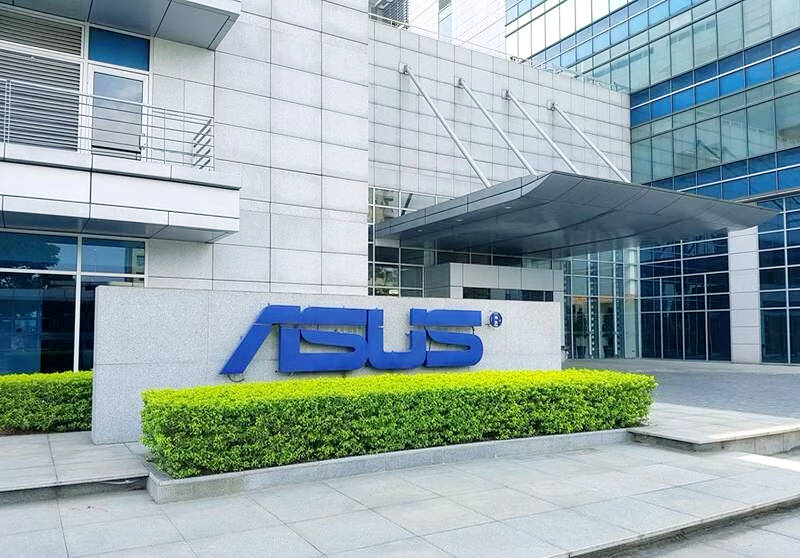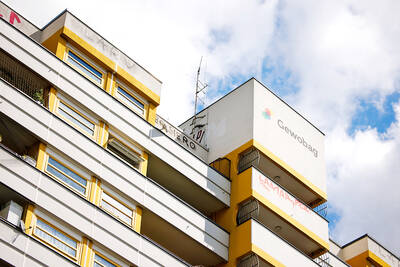Computer vendor Asustek Computer Inc (華碩) yesterday said it aims to return to the black this quarter after its inventory reduced to a stable level, and it narrowed quarterly losses last quarter amid a fragile pickup in consumer demand.
The projection is better than its estimates two months ago. Asustek told investors in March that operating margin would drift into negative territory in the first two quarters of this year.
As the company reduced its inventory to a manageable level last quarter, Asustek said that there is a high likelihood that its bottom line would reach a break-even point this quarter, earlier than expected.

Photo: Fang Wei-chieh, Taipei Times
The company’s inventory dropped 40 percent year-on-year to NT$115.85 billion (US$3.77 billion), it said.
Asustek plans to maintain inventory at a similar level this quarter, as it is preparing for a peak in seasonal demand in the second half of this year, it said.
The company posted about NT$900 million in reversal of inventory write-downs during the January-March period, reflecting the company’s strong inventory management, it said.
“The industry’s overall inventory has improved and is approaching a healthy level, with channel stockpile dropping to pre-COVID-19 pandemic levels,” Asustek chief executive officer Samson Hu (胡書賓) told an investors’ conference yesterday.
“Inventory is not a crucial problem. Market demand is our focus,” Hu said. “During the second quarter, we are seeing demand creep up. Supply chains remain conservative about pulling products.”
PC shipments are to expand 20 percent sequentially during this quarter, supported by recovering demand from consumer models and gaming computers, Asustek said.
Entering the sector’s peak season next quarter, the company expects PC shipments to grow by a double-digit percentage, it said.
Shipments of motherboards and graphics cards are to contract 5 percent quarter-on-quarter during this quarter, which is better than a double-digit percentage decline previously posted during the slack season, it said.
PCs accounted for 59 percent of the company’s total revenue last quarter, while motherboards and graphics cards made up 40 percent, it said, adding that smartphones accounted for 1 percent.
The company posted a quarterly loss of NT$1.68 billion last quarter, compared with a loss of NT$3.82 billion in the fourth quarter of last year. That was the second unprofitable quarter for the PC brand based in Taipei’s Beitou District (北投).
Earnings per share were minus -NT$2.3 last quarter, an improvement on minus-NT$5.1 in the previous quarter.
During the first quarter of last year, the company posted net profit of NT$10.43 billion, or earnings per share of NT$14.
Operating profit margin improved to minus-3.6 percent last quarter, from minus-4.2 percent in the fourth quarter of last year — down from 7.9 percent a year earlier.

When an apartment comes up for rent in Germany’s big cities, hundreds of prospective tenants often queue down the street to view it, but the acute shortage of affordable housing is getting scant attention ahead of today’s snap general election. “Housing is one of the main problems for people, but nobody talks about it, nobody takes it seriously,” said Andreas Ibel, president of Build Europe, an association representing housing developers. Migration and the sluggish economy top the list of voters’ concerns, but analysts say housing policy fails to break through as returns on investment take time to register, making the

EARLY TALKS: Measures under consideration include convincing allies to match US curbs, further restricting exports of AI chips or GPUs, and blocking Chinese investments US President Donald Trump’s administration is sketching out tougher versions of US semiconductor curbs and pressuring key allies to escalate their restrictions on China’s chip industry, an early indication the new US president plans to expand efforts that began under former US president Joe Biden to limit Beijing’s technological prowess. Trump officials recently met with their Japanese and Dutch counterparts about restricting Tokyo Electron Ltd and ASML Holding NV engineers from maintaining semiconductor gear in China, people familiar with the matter said. The aim, which was also a priority for Biden, is to see key allies match China curbs the US

NOT TO WORRY: Some people are concerned funds might continue moving out of the country, but the central bank said financial account outflows are not unusual in Taiwan Taiwan’s outbound investments hit a new high last year due to investments made by contract chipmaker Taiwan Semiconductor Manufacturing Co (TSMC, 台積電) and other major manufacturers to boost global expansion, the central bank said on Thursday. The net increase in outbound investments last year reached a record US$21.05 billion, while the net increase in outbound investments by Taiwanese residents reached a record US$31.98 billion, central bank data showed. Chen Fei-wen (陳斐紋), deputy director of the central bank’s Department of Economic Research, said the increase was largely due to TSMC’s efforts to expand production in the US and Japan. Investments by Vanguard International

STRUGGLING TO SURVIVE: The group is proposing a consortium of investors, with Tesla as the largest backer, and possibly a minority investment by Hon Hai Precision Nissan Motor Co shares jumped after the Financial Times reported that a high-level Japanese group has drawn up plans to seek investment from Elon Musk’s Tesla Inc to aid the struggling automaker. The group believes the electric vehicle (EV) maker is interested in acquiring Nissan’s plants in the US, the newspaper reported, citing people it did not identify. The proposal envisions a consortium of investors, with Tesla as the largest backer, but also includes the possibility of a minority investment by Hon Hai Precision Industry Co (鴻海精密) to prevent a full takeover by the Apple supplier, the report said. The group is